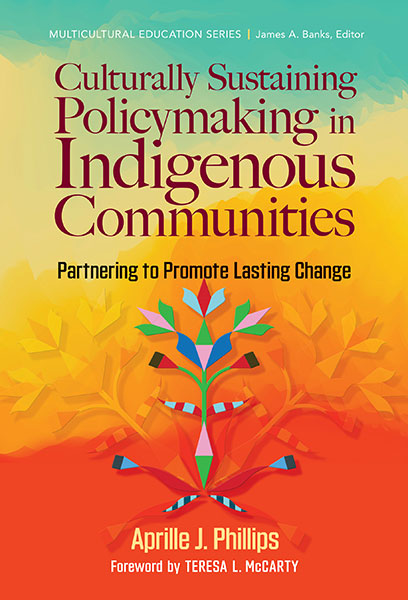Professors: Request an Exam Copy
Print copies available for US orders only. For orders outside the US, see our international distributors.
Foreword by: Teresa L. McCarty
Publication Date: January 26, 2024
Pages: 192
Series: Multicultural Education Series

Discover how top-down, policy-into-practice educational mandates have adversely affected Indigenous communities in the United States’ midwestern core. The author scrutinizes how leaders and intermediaries in Nebraska, involved at various tiers of policy development and reform, conceptualized and implemented school accountability policy in Indian country. In particular, Phillips explores state-directed reform efforts in a school on the Santee Sioux Reservation consistently labeled as failing and persistently experiencing intervention from outsiders presented as experts. The book interrogates who gets to define educational quality, who counts as an expert on improving schools, and what improvement actually looks like. Additionally, the text highlights the way local educators and members of the community employed everyday tactics and incognito acts of improvement to reshape school turnaround efforts. Readers will see what is possible for education policy done with—rather than to—Native communities and schools, with lessons that have relevance beyond the midwestern states.
Book Features:
Aprille J. Phillips is an associate professor of education at the University of Nebraska at Kearney.
“A clear, accessible, and often personal narrative . . . Culturally Sustaining Policymaking in Indigenous Communities provides the fields of education, anthropology, and Native American/Indigenous Studies with a richly described, thoughtful, and timely account of the innerworkings of education ‘reform,’ laying bare the ways in which state-level safety zones serve to reinscribe systems of oppression, and revealing the policy improvisation and push-back of Indigenous nations, communities, and schools.”
—From the Forewod by Teresa L. McCarty, distinguished professor, University of California, Los Angeles, and coauthor (with K. Tsianina Lomawaima) of "To Remain an Indian" Lessons in Democracy from a Century of Native American Education
“Phillips's account of Nebraska's aim to improve failing public schools—at times reading like an intricate story with complex plots and characters—offers readers a personal and critical look into the ongoing struggle between colonizing state reforms and Dakota survival and resistance. A compelling lesson for non-Native policymakers and educators to understand why Indigenous peoples must be present and heard when the education of their children is at stake.”
—John P. Hopkins, chief diversity officer and director of the Diversity and Equity Center, Saint Martin’s University, and author of Indian Education for All.
Contents
Series Foreword James A. Banks ix
Foreword: Toward a Praxis of Indigenous Education Sovereignty Teresa L. McCarty xiii
Acknowledgments xix
Introduction 1
Democracy and School Reform 3
Grounding Terminology and Conceptual Framing 4
School Policy Reform in Indian Country 8
Policy Culture and Culturally Sustaining Policymaking 9
Methodology and Positionality 10
Overview of Chapters 12
1. So What? Lessons Learned and Why They Matter 15
Accountability: What Came Before 18
No Child Left Behind 20
NCLB Limbo 21
The Role of State Departments of Education 25
SDEs, Policy, and Power 27
Spatial Tactics as Resistance 28
2. Welcome to Flyover Country 29
Accountability and Nebraska’s AQuESTT 30
The Nebraska Way 31
A Nebraska Way of Education Governance 33
The Nation’s Only Unicameral 33
A Bill’s Journey Through the Unicameral 34
A Brief History of Schooling and Governance in Nebraska 35
Policy Landscape and Key Figures 36
The Shifting Roles of NDE 40
3. A Broader Story Than the Village of Santee 43
Early Interactions with Colonizers 44
A Dakota Education 45
“Big Knives” and the “Physical and Moral Degradation” of Reservation Life 47
School as a Policy Tool 48
Sovereignty, Self-Determination, and Self-Education 50
Agency, Survivance, and Schooling 52
What’s a “Good” Education? 53
Culturally Sustaining and Responsive Pedagogy 54
Culturally Sustaining/Revitalizing Education Policymaking 55
4. Policy Crafted on the Legislative Floor 57
The Introduction of LB438 58
Public Hearing: A Better Way to “Fix” Schools 59
LB438 and the Second Session of Nebraska’s 103rd Legislature 61
LB438 Becomes Law 69
5. Nebraska’s AQuESTT: Bolder, Broader, Better 71
The SBOE Hires a New Commissioner of Education 72
From Vision to Plans on Paper 76
Codifying AQuESTT 79
Sketching out AQuESTT’s Implementation 80
Bolder, Broader, Better 81
Inching Closer to Classification/Designation 83
The First AQuESTT Classification and Designation 85
A Retrospective View 88
6. Run by Outsiders 91
Initial Thoughts About Improvement in Santee 92
A Diagnostic Review 95
State Plan Development 98
Priority Schools: Developing Progress Plans 100
Progress Plan Approval and Initial Implementation 106
7. Compliance, Kind Of 115
Reporting First-Year Progress 122
Continued Compliance, Kind of . . . and Incognito Improvement Efforts 124
Incognito Improvement Acts Endure 129
8. Wait, What Just Happened? 133
The “Consultocracy” 134
Sovereignty and Who Gets to Define Educational Quality 136
Everyday Tactics and Incognito Acts of Improvement 138
The Decolonizing Work of Culturally Sustaining Policymaking 139
Conclusion 141
Afterword 143
A Final Trip to Santee 143
The iSanti Ozuyapi at State 143
References 145
Index 161
About the Author 171
Professors: Request an Exam Copy
Print copies available for US orders only. For orders outside the US, see our international distributors.